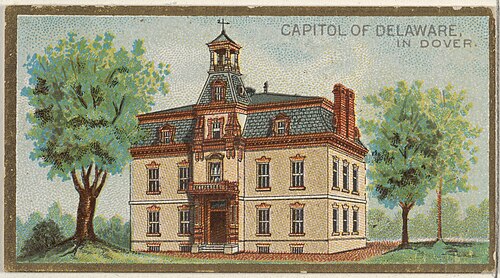
Delaware’s history is a microcosm of America’s broader narrative, reflecting early encounters between Indigenous peoples and European explorers, the struggles and triumphs of colonial expansion, and the evolving political landscape that shaped the United States. As the first state to ratify the U.S. Constitution, Delaware occupies an esteemed position in American history. Its story begins with the Lenni-Lenape people and unfolds through waves of Dutch, Swedish, and English settlements, culminating in a proud tradition of commerce, industry, and governance. From colonial disputes and Revolutionary fervor to Civil War tensions and modern advancements, Delaware’s journey is marked by resilience and a capacity for innovation that continues to define the “First State” today.
Research your ancestors on MyHeritage
Early Inhabitants and European Colonization (Pre-1600s – 17th Century)
- Pre-Colonial Era (Prior to 1600s): The region now known as Delaware is inhabited by the Lenni-Lenape (also called Delaware Indians), an Algonquian-speaking tribe. These Native American communities develop sophisticated trade networks and agricultural practices, setting the cultural foundations of the region.
- 1609: English navigator Henry Hudson sails into Delaware Bay while working for the Dutch East India Company, marking one of the earliest European contacts with the region.
- 1631: Dutch Settlement: The Dutch establish the trading post Zwaanendael (near present-day Lewes), Delaware’s first European settlement. Conflict with local Native Americans leads to the destruction of Zwaanendael within a year.
- 1638: Swedish Influence: Swedish settlers establish Fort Christina (in present-day Wilmington), founding the colony of New Sweden along the lower Delaware River. This is the first permanent European settlement in the area that lasts beyond a few years.
- 1651–1655: Dutch Reconquest: The Dutch erect Fort Casimir (near present-day New Castle) to regain control of the territory. The Swedes briefly recapture Fort Casimir, but the Dutch, led by Peter Stuyvesant, successfully reclaim the region in 1655.
- 1664: English Takeover: The English seize control from the Dutch. Delaware becomes part of the English colonial holdings, eventually administered alongside New York.
- 1682: William Penn’s Proprietorship: The Duke of York transfers control of the “Three Lower Counties on the Delaware” (today’s Delaware) to William Penn. Delaware is governed jointly with Pennsylvania for a period, though each maintains separate regional identities.
Political development and transition to Independence (18th Century)
- 1704: Separate Assembly: Delaware establishes its own legislative assembly, distinct from Pennsylvania’s. This marks an important step toward self-governance and foreshadows future independence.
- Mid-1700s: Growth & Colonial Disputes: Tensions increase between colonists and British authorities over taxation and representation. Delaware’s economy revolves around farming, trade, and shipbuilding along the Delaware River.
- 1776: Declaration of Independence: During the American Revolution, Delaware’s assembly declares independence from both Pennsylvania and Britain, forming the Delaware State. Caesar Rodney’s historic overnight ride ensures Delaware’s vote for independence in the Continental Congress.
- 1787: First State: On December 7, Delaware becomes the first state to ratify the U.S. Constitution, earning its nickname “The First State.”
State-wide development and Civil War (19th Century)
- 1802: Beginnings of DuPont: Éleuthère Irénée du Pont establishes a gunpowder mill on the Brandywine River, laying the foundation for what will become one of America’s largest chemical companies.
- Early to Mid-1800s: Industrial & Agricultural Development: Delaware thrives on shipbuilding, milling, and agriculture, especially peaches and wheat. The expansion of canals and roads spurs commerce and trade.
- Civil War Era (1861–1865): Although Delaware is a slave state, it does not secede from the Union. The state’s political climate reflects divided sentiments, but ultimately remains loyal to the Union.
- Post-Civil War Reconstruction & Late 1800s: Slavery is abolished, though racial inequalities persist. Railroads and industrial growth help transition Delaware toward modern manufacturing and commerce.
- 1897: New Delaware Constitution: A constitution is adopted to address modern governance needs, updating legal and administrative structures.
20th Century: Economic expansion
- Early 20th Century: Continued economic and industrial expansion, led by companies like DuPont, solidifies Delaware’s reputation for innovation. Wilmington becomes a hub of manufacturing and financial services.
- 1930s–1940s: Great Depression & WWII: Delawareans experience economic challenges during the Great Depression, but New Deal programs provide relief. During World War II, Delaware’s strategic location on the Atlantic coast contributes to military and industrial efforts.
- Post-WWII Boom (1950s–1960s): Rapid growth in suburban areas and heightened economic prosperity. The chemical and automotive industries expand, creating new jobs and attracting residents.
- Late 20th Century:: Financial legislation (such as the Financial Center Development Act of 1981) transforms Delaware into a major banking and corporate hub. Wilmington emerges as a center for credit card and banking operations.
- 21st Century Developments: Delaware continues to lead in corporate law, technology, and science-based industries. Emphasis on environmental conservation and historic preservation grows, reflecting a dual commitment to innovation and heritage.


